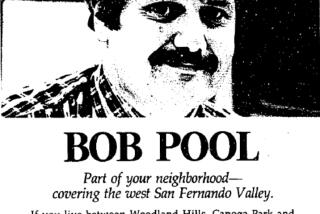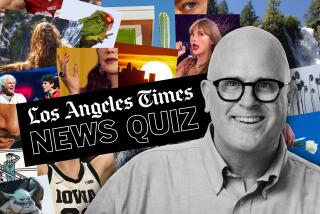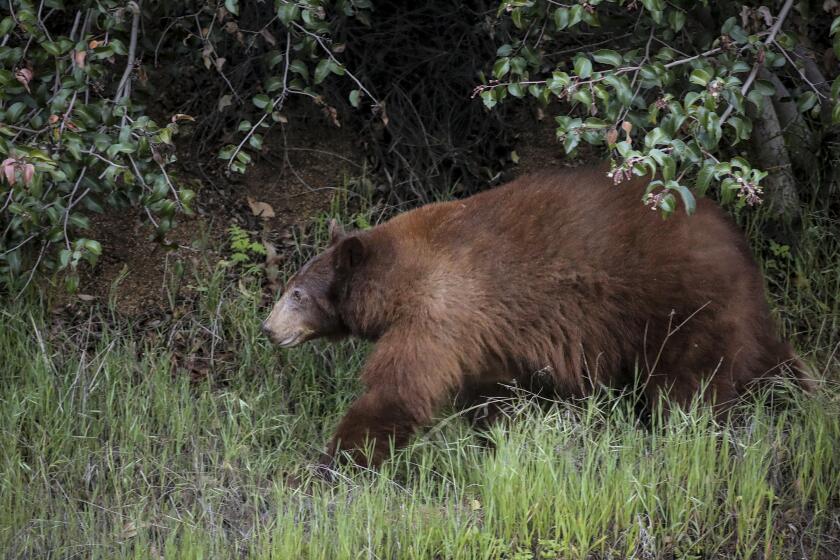Setting Times stories to music: From Lorde to Frankie Valli

I’ve just finished reading “Headline Happy,” a 1950 memoir of L.A. Confidential-style journalism by the wonderfully named Florabel Muir.
She’s a real-world Hildy Johnson (as played by Rosalind Russell in my favorite newspaper movie, “His Girl Friday”). When reading her wisecracking memories of the Hollywood-and-hoodlums beat, I was torn between wishing the journalism racket was still so glam and squirming over the ethics-schmethics of old-school reporting.
The book had me from the first page: “The newspaper game! That’s what we call it. It’s a fast-moving game with changing rules that never make sense....You’ve got to be wacky to stick to it as long as I have.”
I have to share a few other choice quotes:
“I found her sitting amid the ruins of her hopes as I have found many others in my time as a reporter.”
“Getting interviews the easy way by just up and asking the questions bored him.”
“She had an idea that all reporters drank to excess and helled around most of the time, and all she saw in it for me was ultimate ruin and heartbreak.”
And this, from the night Bugsy Siegel was gunned down: “The Los Angeles Times was lying across his knees and on it was stamped: ‘Good Night. Sleep peacefully with compliments of Jack’s.’ Bloody sections of his shattered brain partially blotted out the eight-column headline telling of another fatal shooting in a poorer section of Los Angeles. As I moved the newspaper to see what he had been reading, blood dripped on my satin evening slippers.”
I wouldn’t mind a little bit of this kind of jazzy writing today. Maybe one of my writers will rise to the challenge?
Anyway, in these roundups of the week gone by, I’d like to offer the first paragraphs of each Great Read (or, as they’re known in print, Column One) -- maybe they’ll catch your eye and you can settle in for a good weekend read. And you’ll also get the songs that inspired me while editing the stories, or reading them later if my fellow editor Millie Quan ushered them through. A story-song combo!
#
Gay sports leagues gain ground as a social outlet
Jason Bergquist tugs the laces tight on his Nike cleats and grins at his parents in the front row of the bleachers at the Hollywood Recreation Center. With zero wins for the season, Bergquist’s kickball team has a lot to prove.
His mother snaps iPhone photos of him in his yellow team T-shirt.
“J, you need your water?” she asks through the dugout’s chain-link fence.
“Not yet, Mom.”
His father can’t stop smiling. “This reminds me of when the kids were little!” he says before trying to persuade other fans to do the wave.
Bergquist, 34, is playing for the Racine team of the Varsity Gay League, one of Southern California’s largest recreational sports organizations specifically for gay people.
He joined the league this year, still reeling from a breakup with a longtime boyfriend. Frustrated and lonely, he promised himself he’d put himself out there and meet new people.
“My parents had been softly encouraging me to begin making new friends and start dating again,” said Bergquist, whose parents are visiting from Seattle. “And they’ve been worried about me meeting people at bars.”
He was looking for more genuine friendships anyway, he said. At a bar, he said, people — gay or straight — are trying to impress. In competitive team sports, they have to rely on one another.
#storysongs combo: “Team,” by Lorde. I’ve been trying to listen to this New Zealand teen, but still am not quite feeling all the buzz about her.
#
Crafting fake eyes is family business, rifts included
Little-known fact about the little-known world of ocularists: During World War II, supplies of the German glass used for making prosthetic eyes fell, so the U.S. Army organized a team to figure out a way to make the eyes using plastic.
Borrowing from techniques used in dentistry, the Army team cast molds of patients’ injured eye sockets and used the impressions to make acrylic prosthetics.
Frederick Lewis was on the Army team at Walter Reed Hospital. After the war, he came to Los Angeles, ending up with offices in Beverly Hills, Tarzana and Santa Barbara.
During a career that spanned nearly six decades, Lewis fashioned tens of thousands of lifelike orbs — painting irises and pupils and veins on acrylic shells and popping them into patients’ eye sockets.
Lewis made prosthetics for members of Los Angeles society; for combat victims and cancer sufferers; for working types who had lost eyes doing tough manual labor.
His daughter, Carole, joined him in the mid-1980s, running the family’s offices. After Lewis died, Carole’s son, John Stolpe, also signed on, training with his mother and learning the trade.
The Lewises aren’t unusual — ocularists tend to keep things in the family. Ask an ocularist for a list of a few families in the business, and he’ll rattle off names with scarcely a thought: The Gougelmanns in New York. The Jarhrlings in Boston. The Kelleys in Philadelphia and Baltimore. The LeGrands in Philadelphia and Virginia. The Lewises in Los Angeles.
Parents take their children to work. Sometimes, when the children grow up, they marry someone from another ocularist family.
And sometimes, as in the best of families, they fight.
#storysongs combo: I chose “My Eyes Adored You,” by Frankie Valli, a song whose hook I love but whose lyrics make me a bit queasy. But co-worker Ken Olsen had a better pick: “I Only Have Eyes for You,” by the Flamingos. Love how the videos show actual 45’s being played.
#
These odd monuments give a quirky history lesson
Sure, the Lincoln Memorial and Washington Monument are must stops for visitors touring the nation’s capital.
But what about Sonny Bono Park?
Or the Maine Lobsterman Memorial?
Or the Cuban Friendship Urn?
They’re all here, as are scores of bronzes, shrines, pillars, plaques and monoliths dedicated to the unexpected and the obscure.
The father of homeopathy? He’s got a monument. So does James Buchanan, regarded as among the nation’s worst presidents.
And don’t miss the Bernard Baruch Bench of Inspiration.
“I just came here because no one was sitting here,” said Nikolai Paneck, an 18-year-old tourist. He was unaware that he was occupying a bench dedicated in 1960 to honor the financier and presidential advisor who liked to sit at this spot in Lafayette Park opposite the White House.
These monuments are like a lot of the politicians in this town — in search of recognition. They also illustrate how some topics (like temperance) and people (like inventor John Ericsson) hold and then lose the spotlight. And this being Washington, the success of some commemorative projects shows the ever-present power of influence.
#storysongs combo: “The Statue Got Me High,” by They Might Be Giants. I can handle this jokey band only in small doses. This one is a fun small dose.
#
Weddings rescue a struggling Calif. dairy
A leggy bridesmaid smoothed her Grecian-pleated dress and stuffed lipstick and two cigars into her cowboy boots.
Over by the horses, the best man slipped a flask out of his vest and offered a mare a sip.
The preacher was late, but everything else was on schedule for the sunset wedding at the Double T. The cows had been herded from the pasture to make room for cars, and the barn was hung with white lights and Mason jars.
Dairy weddings are now the stuff of bridal dreams.
“Lately, it’s a trend,” said Tony Azevedo, the owner of the Central California dairy, which has been hosting nuptials for more than 20 years. “It’s just that they don’t call them dairy weddings, because people tend to think about flies and manure. It’s ‘barn weddings’ or ‘farm setting.’”
In the latest Kelly Clarkson music video, newlyweds share a kiss in front of Azevedo’s cows. The dairy wedding photos of another couple are in a video for country singer Jason Aldean. Antique milk cans and bales of hay are objects of lust on Pinterest, a social media bulletin board particularly favored by brides-to-be.
“This Pinterest thing is my new business partner,” said Azevedo, 61, with a shake of his cowboy hat. “Everybody wants to get married in a damn barn and have their picture taken with a cow.”
California’s dairy industry needs all the help it can get: More than 100 farms went out of business last year alone. Dairy families are hoping that love can save the day by paying some of the bills.
#storysongs combo: “Ashokan Farewell,” by Jay Ungar. I thought the fiddle in this beautiful song worked well with the farm theme.
#
Memories of beloved pets live on at cemetery
Jazz, a cocker spaniel with curly black hair, has died. He was 13 years old.
He succumbed to heart disease and old age at an animal hospital in Studio City.
A 24-pound dog who confronted bull mastiffs and Rottweilers twice his size, Jazz was remembered by his family as a flop-eared hunter known to terrorize cats with an unblinking stare.
He is survived by Greg Poland, his wife, Shelly, and their 4-year-old daughter, Ameera. Funeral services were held at the Los Angeles Pet Memorial Park in Calabasas.
Sheets of blue film cover the windows of the viewing room at the Calabasas graveyard, casting an eerie glow over the Poland funeral party. A jug of water and a glass bowl of brown cookies — for man or animal, it’s unclear — sit untouched.
Sitting on a bench beneath a holographic dog portrait, Shelly Poland writes a letter to Jazz.
Jazz was really his wife’s dog, Greg says. He never wanted a pet and when Jazz died, Greg floated the idea of burying him in the backyard, a suggestion quickly withdrawn.
But Greg was one of Jazz’s primary caretakers. He took the dog for walks, hollered at him during potty training, laughed when Jazz challenged bigger dogs. He indignantly recalls how the family learned of their dog’s death from the groomers’ where Jazz had collapsed.
“The guy …was like, ‘Sir, your dog is dead’ — like he was telling me my cheeseburger was ready,” he says.
Shelly finishes the letter and places it in the casket. The party gathers around Jazz, who rests in a pebbled gray plastic casket lined with crushed blue velvet.
Ameera takes a plastic cup full of water and places it next to Jazz’s head, his last drink. Shelly clips some of Jazz’s fur as a memento and puts it in a zip-lock bag. Artemio Cristerna, the cemetery’s longtime groundskeeper, closes the casket. It’s time to leave, but Shelly cannot. She rushes back to the viewing room, cracks open the casket, and whispers.
“Bye, Jazzy.”
#storysongs combo: “Pet Sematary,” by the Ramones. I agree with co-worker Mary Braswell: Had to be this song.
#
If you have ideas for story-song pairings of your own, tweet the title and artist to @karihow or @LATgreatreads with the hashtag #storysongs.
Twitter: @karihow
More to Read
Start your day right
Sign up for Essential California for news, features and recommendations from the L.A. Times and beyond in your inbox six days a week.
You may occasionally receive promotional content from the Los Angeles Times.






